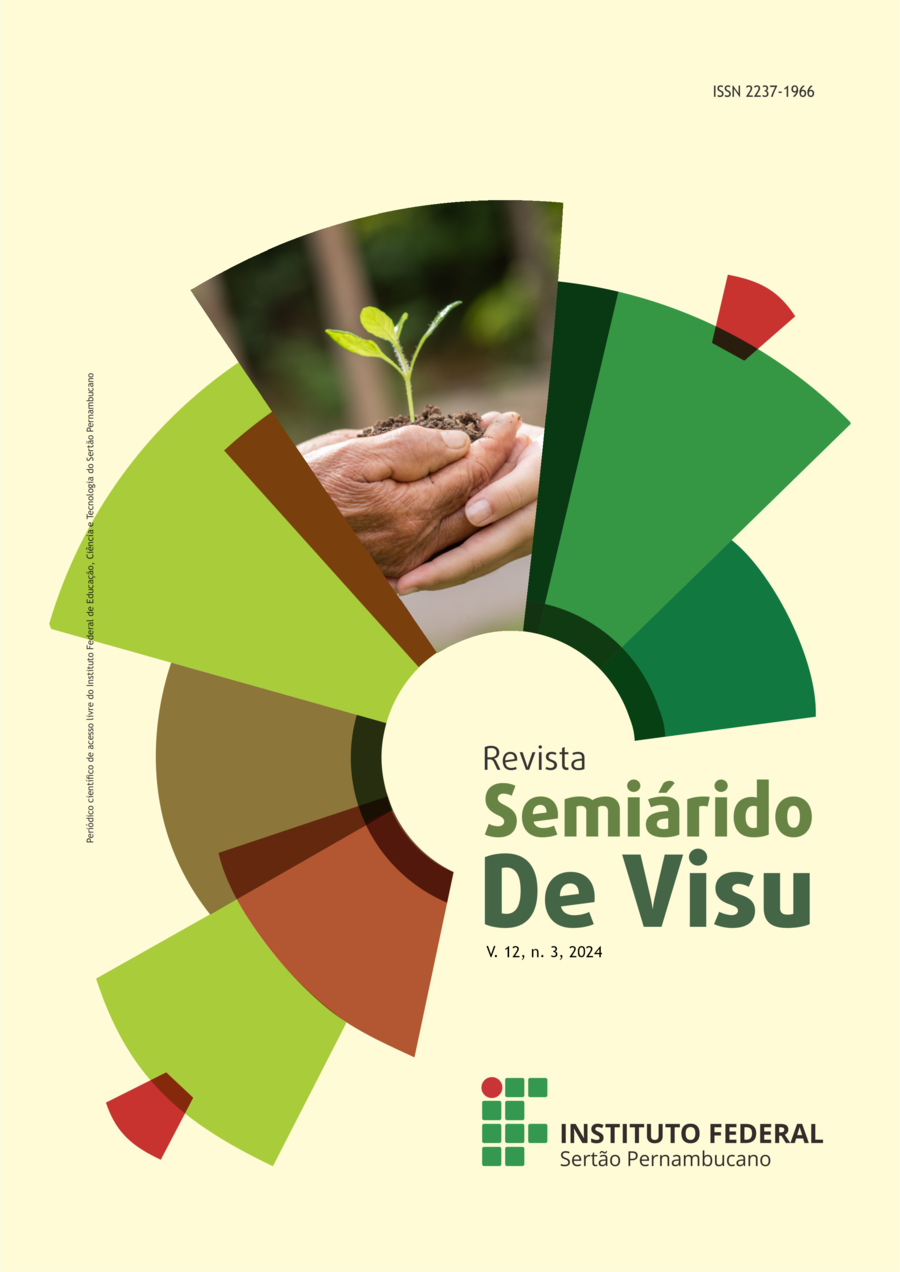The antibacterial effects of an aqueous extract of yerba-mate (Ilex paraguariensis) leaves and twigs on pathogenic bacteria
Visualizações: 275DOI:
https://doi.org/10.31416/rsdv.v12i3.997Palavras-chave:
Ilex paraguariensis, antimicrobiano, resíduo, antioxidanteResumo
A atividade antibacteriana da erva-mate (EM) e de seus resíduos industriais carece de exploração mais aprofundada. O objetivo do trabalho foi avaliar a atividade antibacteriana contra bactérias patogênicas e o conteúdo polifenólico de folhas e galhos de YM extraídos por diferentes períodos. Staphylococcus aureus, S. epidermidis, Listeria monocytogenes e Escherichia coli foram testados contra extrato aquoso de folhas e galhos de EM e o modo de ação foi avaliado por microscopia. Os resultados mostraram que o extrato aquoso dos galhos inibiu ambas as espécies de Staphylococcus quando a extração ocorreu por 18h. O extrato das folhas apresentou inibição contra S. aureus. L. monocytogenes e E. coli não foram inibidas. A extração realizada por 10 minutos não produziu atividade antibacteriana. Não foi observada diferença significativa na concentração de polifenóis totais ou taninos condensados nos três extratos avaliados. A microscopia mostrou alterações na morfologia da célula bacteriana de S. aureus. EM e seu subproduto são uma fonte promissora de compostos funcionais.
Referências
BOUARAB-CHIBANE, L.B.; FORQUET, V.; LANTÉRI, P.; CLÉMENT, Y.; LÉONARD-AKKARI, L.; OULAHAL, N.; DEGRAEVE, P.; BORDES, C. Antibacterial Properties of Polyphenols: Characterization and QSAR (Quantitative Structure–Activity Relationship) Models. Frontiers in. Microbiology, v.10, e00829, 2019.
BORGES, A.; FERREIRA, C.; SAAVEDRA, M.J.; SIMÕES, M. Antibacterial activity and mode of action of ferulic and gallic acids against pathogenic bacteria. Microbiology and Drug Resistance, v.19, n.4, p.256-265, 2013.
BURRIS, K.P.; DAVIDSON, P.M.; STWART JR, C.N.; ZIVANOVIC, S.; HART, F.M. Aqueous extracts of yerba-mate (Ilex paraguariensis) as natural antimicrobial against Escherichia coli 0157:H7 in microbial medium and pH 6.0 apple juice. Journal of Food Protection, v.75, n.4, p.753-757, 2012.
CAXAMBÚ, S.; BIONDO, E.; KOLCHINSKI, E.M.; LAPPE, R.; BRANDELLI, A.; SANT’ANNA, V. Evaluation of the antimicrobial activity of pecan nut [Carya illinoinensis (Wangenh) C. Koch] shell aqueous extract on minimally processed lettuce leaves. Food Science and Technology, v.36, p.42-45, 2016.
DIARRA, M.S.; HASSAN, Y.I.; BLOCK, G.S.; DROVER, J.C.G.; DELAQUIS, P.; OOMAH, B.D. Antibacterial Activities of a polyphenolic-rich extract prepared from American cranberry (Vaccinium macrocarpon) fruit pomace against Listeria spp. LWT, v.123, e109056, 2020.
FLECK, N.; SANT’ANNA, V.; OLIVEIRA, W.D.C.; BRANDELLI, A.; VERAS, F.F. Jaboticaba Peel Extract as an antimicrobial agent: screening And stability analysis. British Food Journal, v.124, n.9, p.2793-2804, 2022.
FLECK, N.; OLIVEIRA, W.C.; PADILHA, R.L.; BRANDELLI, A.; SANT’ANNA, V. Antimicrobial effect of phenolic-rich jaboticaba peel aqueous extract on Staphylococcus aureus and Escherichia coli. Brazilian Journal of Food Technology, v.26, e2022087, 2023.
GIRARDI, I.; PADILHA, R.L.; SANT'ANNA, V. Sugarcane bagasse: analysis of polyphenols, compounds with antioxidant and antimicrobial activities. Tecno-lógica, v.23, n.1, p.59-62, 2019.
JONES, G.A.; MCALLISTER, T.A.; MUIR, A.D.; CHENG, K.-J. Effects of Sainfoin (Onobrychis viciifolia Scop.) condensed tannins on growth and proteolysis by four strains of ruminal bacteria. Applied Environmental Microbiology, v.60, p.1374–1378, 1994.
KHAMENEH, B.; IRANSHAHY, M.; SOHEILI, V.; FAZLY BAZZAZ, B.S. Review on plant antimicrobials: A mechanistic viewpoint. Antimicrobial Resistance and Infection Contamination, v.8, n.1, e118, 2019.
KHORSHIDIAN, N.; YOUSEFI, M.; KHANNIRI, E.; MORTAZAVIAN, A.M. Potential application of essential oils as antimicrobial preservatives in cheese. Innovative Food Science and Emerging Technology, v.45, p.62-72, 2018.
LAPPE, R.; MOTTA, A.S.; SANT’ANNA, V.; BRANDELLI, A. Inhibition of Salmonella Enteritidis by cerein 8A, EDTA and sodium lactate. International Journal of Food Microbiology, v.135, n.3, p.312–316, 2009.
MAZZA, G.; FUKUMOTO, L.; DELAQUIS, P.; GIRARD, B.; EWERT, B. Anthocyanins, Phenolics, and color of Cabernet Franc, Merlot, And Pinot Noir wines from British Columbia. Journal of Agricultural and Food Chemistry, v.47, p.4009-4017, 1999.
MOLVA, C.; BAYSAL, A. H. Antimicrobial activity of grape seed extract on Alicyclobacillus acidoterrestris DSM 3922 vegetative cells and spores in apple juice,” Food Science and Technology, v.60, n.1, p.238-245, 2015.
NOHYNEK, L.J.; ALAKOMI, H.L.; KÄHKÖNEN, M.; HEINONE, M.; HELANDER, I.M.; OKSMAN-CALDENTEY, K.M.; PUUPPONEN-PIMIÄ, R. Berry phenolics: antimicrobial properties and mechanisms of action against severe human pathogens. Nutrition Cancer, v.54, n.1, p.18–32, 2006.
PENTEADO JÚNIOR, J.F.; GOULART, I.C.G.R. Poda Em erva-mate plantada. In: Documentos Embrapa, 313, 1-28 (2017).
RE, R.; PELLEGRINI, N.; PROTEGGENTE, A.; PANALA, A.; YANG, M.; RICE-EVANS, C. Antioxidant activity applying an improved ABTS radical cation decolorization assay. Free Radical Biology and Medicine, v.26, p.1231–1237, 1999.
SANT’ANNA, V.; BIONDO, E.; KOLCHISNKI, E.M.; DA SILVA, L.F.S.; CORRÊA, A.P.F.; BACH, E.; BRANDELLI, A. Total polyphenols, antioxidant, antimicrobial and allelopathic activities of spend coffee ground aqueous extract. Waste and Biomass Valorization, v.8, p.439-442, 2017.
SINGH, R.; RAY, P.; DAS, A.; SHARMA, M. Penetration of antibiotics through Staphylococcus aureus and Staphylococcus epidermidis biofilms. Journal of Antimicrobial Chemotherapy, v.65, n.9, p.1955-1958, 2010.
SINGLETON, V.L.; ROSSI, J.A. Colorimetry of Total phenolics with 64 phosphomolybdicphosphotungstic acid reagents. American Journal of Enology and Viticulture, v.16, p.144-158, 1965.
TROJAIKE, G.H.; BIONDO, E.; LAPPE, R.; BRANDELLI, A.; SANT’ANNA, V. Antimicrobial activity of Araucaria angustifoglia seed (Pinhão) coat extract and its synergism with thermal treatment to inactivate Listeria monocytogenes. Food and Bioprocess Technology, v.12, p.193-197, 2019.
VASCONCELLOS, A.C.; FRAZZON, J.; NOREÑA, C.P.Z. Phenolic compounds present in yerba mate potentially increase human health: a critical review. Plant Foods for Human Nutrition, v.77, p.495-503, 2022.
WORLD HEALTH ORGANIZATION (WHO). Publishes list of bacteria for which new antibiotics are urgently needed. Acesso em 31/01/2021. available at: https://www.who.int/news/item/27-02- 2017-who-publishes-list-of-bacteria-for-which-new-antibiotics-are-urgently-needed (accessed 20 january 2021).
ZIELINSKI, A.A.F.; ALBERTI, A.; BONA, E.; BORTOLINI, D.G.; BENVENUTTI, L.; BACH, F.; DEMIATE, I.M.; NOGUEIRA, A. A multivariate approach to differenciate yerba-mate (Ilex paraguariensis) commercialized in the Sourthen Brazil on the basis of phenolics, methylxanthines and in vitro antioxidant activity. Food Science and Technology, v.40, n.3, p.644-652, 2020.
Downloads
Publicado
Como Citar
Edição
Seção
Licença
Copyright (c) 2024 Revista Semiárido De Visu

Este trabalho está licenciado sob uma licença Creative Commons Attribution 4.0 International License.















